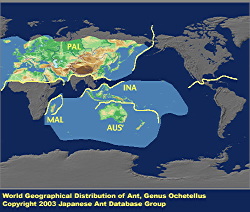
|
genus
|
Ochetellus
|
 |
Japanese Name
|
Ruri-ari-zoku
|
Original Reference
|
|
Shattuck, S.O. (1992) Review of the dolichoderine ant genus Iridomyrmex Mayr with descriptions of three new genera. Journal of the Australian Entomological Society 31: 13-18.
|
Synonym
|
|
Iridomyrmex Mayr, 1862 (Shattuck, 1992, in parts)
|
Description
|
|
Small ants: most workers less than 3 mm in total length. Eyes well developed, situated well forwards on head capsule. Anterior clypeal margin more or less convex medially. Mandibles broad, triangular. Palpal formula 6:4. Antennae 12-segmented. Ochetellus is easily distinguished from other Japanese dolichoderine genera as follows: Head and mesosoma not strongly punctate. Petiole an erect, transverse, high, thin scale; not overhung by first gastral segment.
|
|

|
Remarks
|
|
Shattuck (1992) divided Iridomyrmex (sens. lat.) into several genera, assigning I. itoi (= I. glaber) to the genus Ochetellus, a placement accepted here. The genus Iridomyrmex is thus not known currently to be represented in Japan. Ochetellus has around 7 recognized named species, and is represented in the Palaearctic, Oriental and Indo-Australian areas. Several tramp species have been widely distributed by human commerce. O. glaber is the only known Japanese species.
|
Comment
|
|
In the Japanese-language version of this work the species Ochetellus itoi was referred to genus Iridomyrmex, where it had been placed since original description. Subsequently, Shattuck (1992) has divided Iridomyrmex (sens. lat.) into several genera, assigning I. itoi to the genus Ochetellus, a placement accepted here.
|
References
|
|
- Review of the dolichoderine ant genus Iridomyrmex Mayr with descriptions of three new genera. Journal of the Australian Entomological Society 31: 13-18.
|
Editor
|
|
Original text and English translation by Mamoru Terayama and Masao Kubota, edited by Kazuo Ogata and Robert W. Taylor.
|
|